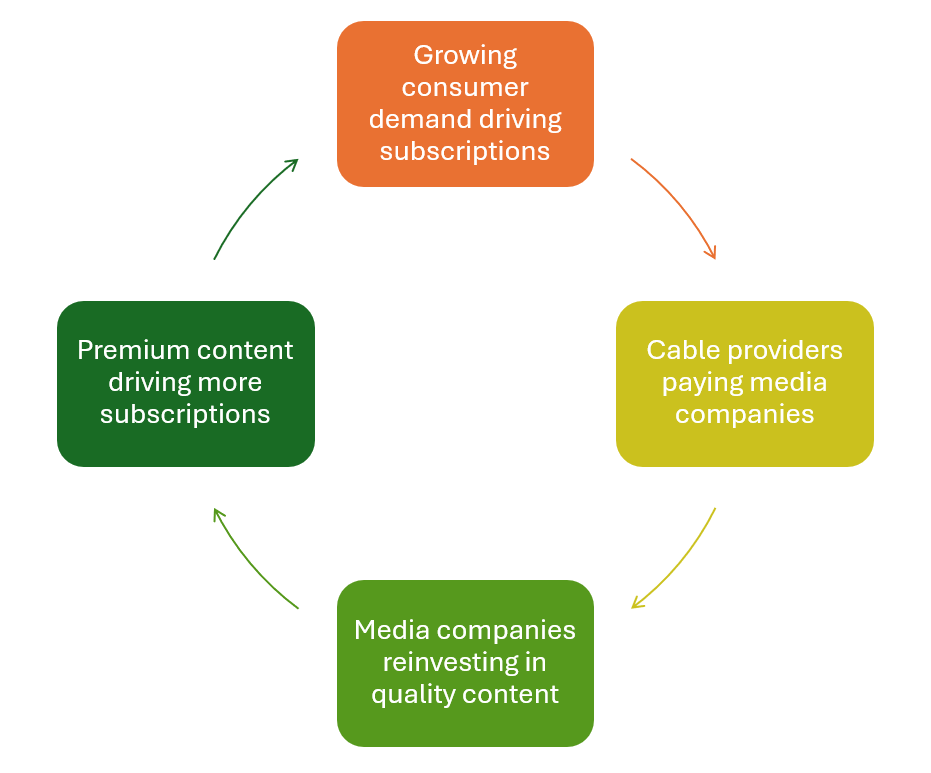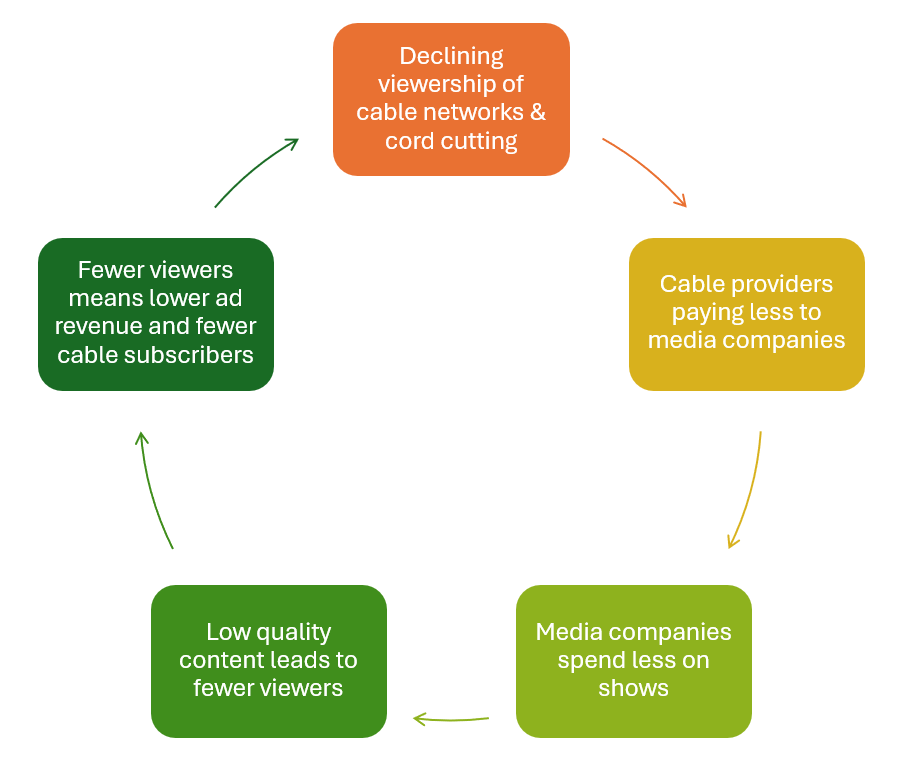On a recent episode of the Vergecast (a podcast worth listening to) one of the topics is about the state of the cable TV business. Host David Pierce predicts “traditional cable TV is going to be basically dead and gone” in 2025.
This is a topic I can speak to with some actual knowledge having worked in the television industry for 30+ years, with specific work in cable.
Back in the late 90s, cable TV was on the rise. There was no concept of internet steaming and large media companies were cashing some fat checks from cable TV revenue. I led the buildout of the Disney Channel playback facility in 1996 and was told to reserve space for many more channels.
To explain the boom in cable channels at the time, I need to explain a little about the economics of the era.
First, remember in the late 90s, the only way to watch “cable television” is via a cable or satellite TV provider (think Comcast or DirecTV). There was no streaming and Youtube didn’t even get started until 2005.
People were watching cable television and their appetite for more seemed unsatiable. I’ll use the term ‘cable provider’ to refer to the companies that managed getting the television signal to the home and provided the set-top box. I use ‘media company’ to refer to the companies that made shows for a cable channel and sent out the signal for a cable provider to use.
The virtuous cycle at the time worked like this.

People were willing to pay cable providers to get access to shows on various cable networks.
Cable providers made money from cable subscriptions.
Cable providers paid media companies for the right to provide the channels to subscribers.
Media companies made money via advertising on cable channels. The more eyeballs the more money.
Media companies invest in more/better shows and more channels to increase demand for cable subscriptions which they request more money from cable providers.
The better the content, the more people subscribed to cable tv, increasing revenue for the cable provider and the media companies (via advertising).
Hence an explosion of cable channels in this era to fill all kinds of niches that people were interested in.
Critical was the negotiations between the media companies and cable providers for the rates paid. In general, media companies were paid a certain price per cable subscriber. These rates ranged from several dollars for top ‘must have’ channels (such as ESPN) to several cents for niche channels.
Media companies held the upper hand in these negotiations as they forced bundles of all their channels onto the cable providers, even though the cable providers didn’t want all the channels. The ‘must have’ channels, like ESPN and Disney Channel, were in demand by people at home, so to get them the cable providers had to accept an entire block of additional channels and agree to pay some cents per subscriber for them as well. Cable providers passed these costs onto people at home, starting the inevitable rise in cable subscription prices.
Slowly, as streaming technology grew, prices for cable went up because Wall Street demands continuous growth every quarter. Stress on the industry grows with difficult negotiations, lots of hardball, and customers frustrated by poor service and price hikes.
Deal points start to hinge on ‘TV Everywhere’ the industry term for granting rights to stream shows online to people who pay for traditional cable. This is where to watch HBO Max online, you could sign in through DirecTV (or whatever cable provider), and watch shows. The backend is complicated and in some ways cripples pure streaming plays due to contractual obligations, but it tempers the anger of frustrated people at home just trying to watch their shows online.
The cable contracts are still huge cash cows for media companies, but nothing gold stays
As the Streaming Wars begin, it is traditional cable that in large part foots the billions to spin up new services within the media companies. As a result, cuts start being made on the cable networks to free up cash so Wall Street remains happy that ‘number go up’.
Thus starts the vicious cycle for cable networks.

As the networks, spend less on shows, viewers look elsewhere. With lower viewership, it hammers the economics in terms of lower advertising revenue and less that can be demanded in per subscriber fees.
With less income, there are less good shows, which leads to drops in ratings, which leads to worse financials for the media companies, who then continue to cut because they need the profit ‘number go up’.
Cord cutting begins in earnest as people are tired of cable bills and start turning to streaming. The pure streaming plays like Netflix, Hulu, Youtube, and others develop into almost complete replacements for traditional cable providers. If the early years, it’s inconsistent and difficult to set up, but the ecosystem begins to form with Roku, Chomecast, Apple, and others bringing simplicity to the home set up.
The early cord cutters preach their gospel to friends and family, and it takes root in millennials and Gen Z who were raised in the internet era. Most people under 40 don’t even consider paying for traditional cable as they can get everything they want over the interwebs.
All that said, there is still a large number of people that turn on the TV in the evening and just flip channels all night and watch live, linear TV for hours on end. The horror. I know. But come to grips with the fact that ~40% of American households still pay for traditional cable TV service, probably paying ~$125-150/month. It remains a juggernaut of cash flow, offsetting other costs in the transition to streaming.
These viewers are mainly the older generations, who still have buying power and some advertisers want to reach. But this group continues to shrink. There is still money to be made, so the businesses continue onwards, slowly shrinking. But the future is in streaming as everyone knows.
You can see the media companies try to adapt with low cost reality shows, police/legal procedurals that appeal to the older demographics, and paying for sports licensing which is truly the only appointment television left.
In the long term, only the cable networks with the highest brand identity will survive the transition to a mainly streaming world. People will talk about what shows they watch but can rarely tell you if they came from a cable network or were only on a streaming provider. A network like Bravo has the needed brand feelings in viewers, but few others do. Bafflingly, Warner Bros. Discovery took one of the most well known cable brands, HBO, and tossed it out the door to call their streaming service Max. People literally know the sound of an HBO sound starting, but couldn’t tell you much about Max.
Yes, the traditional cable TV business is going through some things.
But it will be around quite a while longer because there is still money to be made and a lot of people don’t like change, but they do like their cable remote.
